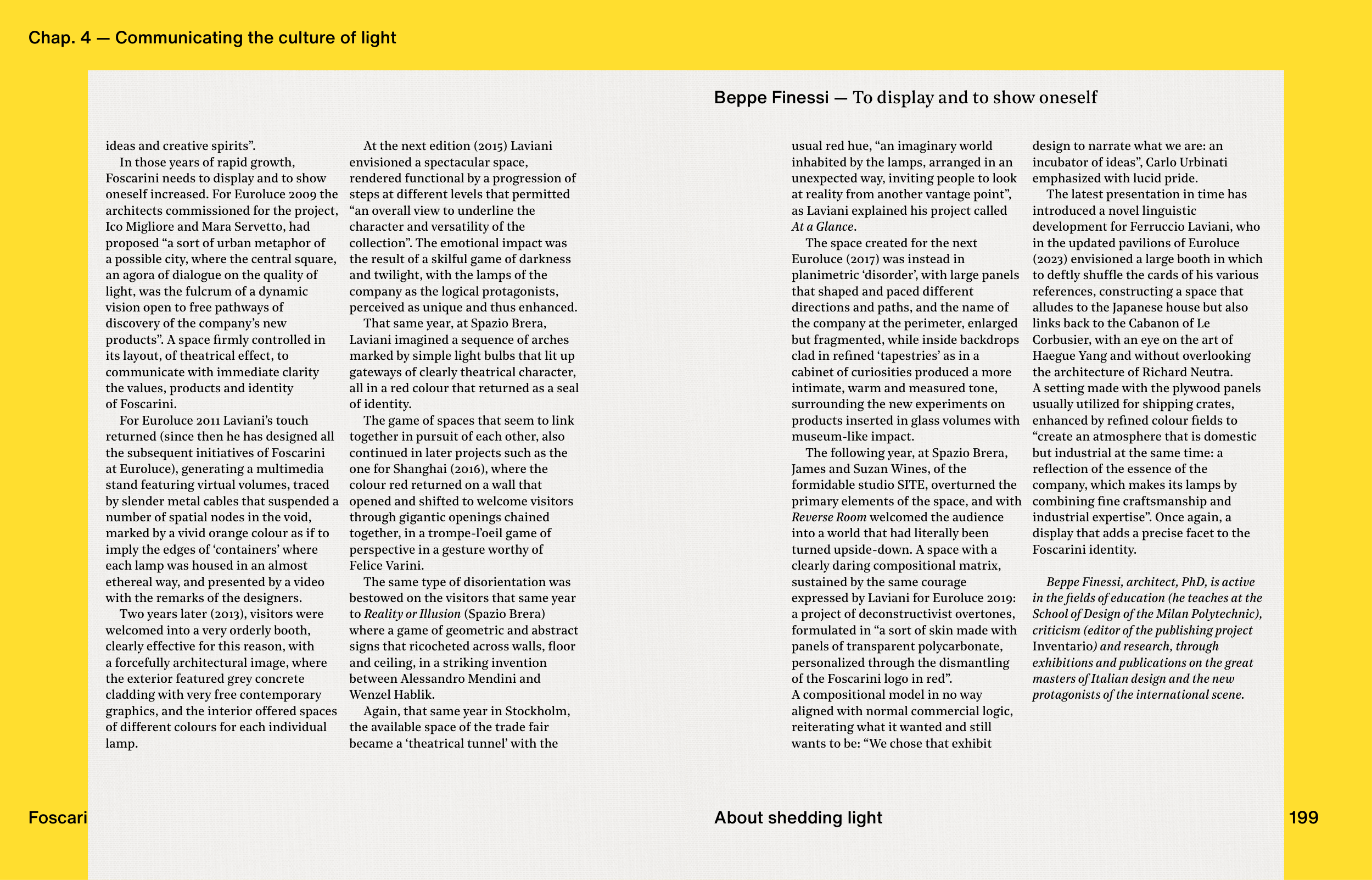199
Foscarini
ideas and creative spirits”.
In those years of rapid growth,
Foscarini needs to display and to show
oneself increased. For Euroluce 2009 the
architects commissioned for the project,
Ico Migliore and Mara Servetto, had
proposed “a sort of urban metaphor of
a possible city, where the central square,
an agora of dialogue on the quality of
light, was the fulcrum of a dynamic
vision open to free pathways of
discovery of the company’s new
products”. A space fi rmly controlled in
its layout, of theatrical effect, to
communicate with immediate clarity
the values, products and identity
of Foscarini.
For Euroluce 2011 Laviani’s touch
returned (since then he has designed all
the subsequent initiatives of Foscarini
at Euroluce), generating a multimedia
stand featuring virtual volumes, traced
by slender metal cables that suspended a
number of spatial nodes in the void,
marked by a vivid orange colour as if to
imply the edges of ‘containers’ where
each lamp was housed in an almost
ethereal way, and presented by a video
with the remarks of the designers.
Two years later (2013), visitors were
welcomed into a very orderly booth,
clearly effective for this reason, with
a forcefully architectural image, where
the exterior featured grey concrete
cladding with very free contemporary
graphics, and the interior offered spaces
of different colours for each individual
lamp.
At the next edition (2015) Laviani
envisioned a spectacular space,
rendered functional by a progression of
steps at different levels that permitted
“an overall view to underline the
character and versatility of the
collection”. The emotional impact was
the result of a skilful game of darkness
and twilight, with the lamps of the
company as the logical protagonists,
perceived as unique and thus enhanced.
That same year, at Spazio Brera,
Laviani imagined a sequence of arches
marked by simple light bulbs that lit up
gateways of clearly theatrical character,
all in a red colour that returned as a seal
of identity.
The game of spaces that seem to link
together in pursuit of each other, also
continued in later projects such as the
one for Shanghai (2016), where the
colour red returned on a wall that
opened and shifted to welcome visitors
through gigantic openings chained
together, in a trompe-l’oeil game of
perspective in a gesture worthy of
Felice Varini.
The same type of disorientation was
bestowed on the visitors that same year
to Reality or Illusion (Spazio Brera)
where a game of geometric and abstract
signs that ricocheted across walls, fl oor
and ceiling, in a striking invention
between Alessandro Mendini and
Wenzel Hablik.
Again, that same year in Stockholm,
the available space of the trade fair
became a ‘theatrical tunnel’ with the
Chap. 4 — Communicating the culture of light
usual red hue, “an imaginary world
inhabited by the lamps, arranged in an
unexpected way, inviting people to look
at reality from another vantage point”,
as Laviani explained his project called
At a Glance.
The space created for the next
Euroluce (2017) was instead in
planimetric ‘disorder’, with large panels
that shaped and paced different
directions and paths, and the name of
the company at the perimeter, enlarged
but fragmented, while inside backdrops
clad in refi ned ‘tapestries’ as in a
cabinet of curiosities produced a more
intimate, warm and measured tone,
surrounding the new experiments on
products inserted in glass volumes with
museum-like impact.
The following year, at Spazio Brera,
James and Suzan Wines, of the
formidable studio SITE, overturned the
primary elements of the space, and with
Reverse Room welcomed the audience
into a world that had literally been
turned upside-down. A space with a
clearly daring compositional matrix,
sustained by the same courage
expressed by Laviani for Euroluce 2019:
a project of deconstructivist overtones,
formulated in “a sort of skin made with
panels of transparent polycarbonate,
personalized through the dismantling
of the Foscarini logo in red”.
A compositional model in no way
aligned with normal commercial logic,
reiterating what it wanted and still
wants to be: “We chose that exhibit
design to narrate what we are: an
incubator of ideas”, Carlo Urbinati
emphasized with lucid pride.
The latest presentation in time has
introduced a novel linguistic
development for Ferruccio Laviani, who
in the updated pavilions of Euroluce
(2023) envisioned a large booth in which
to deftly shuffl e the cards of his various
references, constructing a space that
alludes to the Japanese house but also
links back to the Cabanon of Le
Corbusier, with an eye on the art of
Haegue Yang and without overlooking
the architecture of Richard Neutra.
A setting made with the plywood panels
usually utilized for shipping crates,
enhanced by refi ned colour fi elds to
“create an atmosphere that is domestic
but industrial at the same time: a
refl ection of the essence of the
company, which makes its lamps by
combining fi ne craftsmanship and
industrial expertise”. Once again, a
display that adds a precise facet to the
Foscarini identity.
Beppe Finessi, architect, PhD, is active
in the fi elds of education (he teaches at the
School of Design of the Milan Polytechnic),
criticism (editor of the publishing project
Inventario) and research, through
exhibitions and publications on the great
masters of Italian design and the new
protagonists of the international scene.
Beppe Finessi — To display and to show oneself
About shedding light
199


